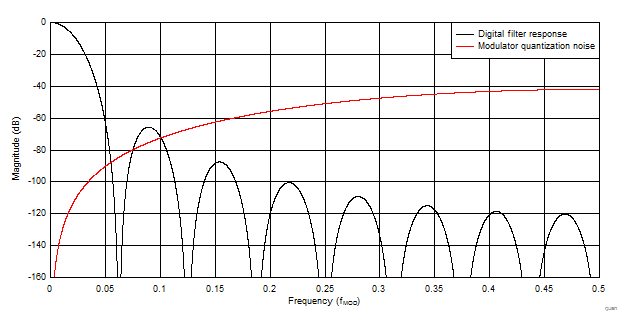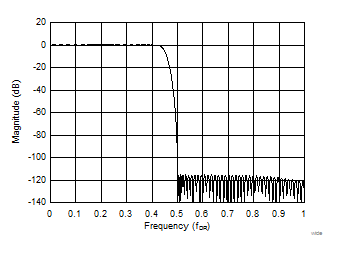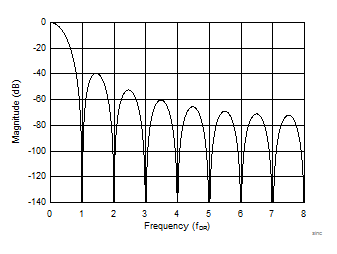SBAA230A May 2017 – March 2023 ADC128D818 , ADS1000 , ADS1000-Q1 , ADS1013 , ADS1013-Q1 , ADS1014 , ADS1014-Q1 , ADS1015 , ADS1015-Q1 , ADS1018 , ADS1018-Q1 , ADS1100 , ADS1110 , ADS1112 , ADS1113 , ADS1113-Q1 , ADS1114 , ADS1114-Q1 , ADS1115 , ADS1115-Q1 , ADS1115L , ADS1118 , ADS1118-Q1 , ADS1119 , ADS1120 , ADS1120-Q1 , ADS112C04 , ADS112U04 , ADS1130 , ADS1131 , ADS1146 , ADS1147 , ADS1148 , ADS1148-Q1 , ADS114S06 , ADS114S06B , ADS114S08 , ADS114S08B , ADS1158 , ADS1174 , ADS1178 , ADS117L11 , ADS1191 , ADS1192 , ADS1194 , ADS1196 , ADS1198 , ADS1202 , ADS1203 , ADS1204 , ADS1205 , ADS1208 , ADS1209 , ADS1216 , ADS1217 , ADS1218 , ADS1219 , ADS1220 , ADS1222 , ADS1224 , ADS1225 , ADS1226 , ADS122C04 , ADS122U04 , ADS1230 , ADS1231 , ADS1232 , ADS1234 , ADS1235 , ADS1235-Q1 , ADS1240 , ADS1241 , ADS1242 , ADS1243 , ADS1243-HT , ADS1244 , ADS1245 , ADS1246 , ADS1247 , ADS1248 , ADS124S06 , ADS124S08 , ADS1250 , ADS1251 , ADS1252 , ADS1253 , ADS1254 , ADS1255 , ADS1256 , ADS1257 , ADS1258 , ADS1258-EP , ADS1259 , ADS1259-Q1 , ADS125H01 , ADS125H02 , ADS1260 , ADS1260-Q1 , ADS1261 , ADS1261-Q1 , ADS1262 , ADS1263 , ADS1271 , ADS1274 , ADS1278 , ADS1278-EP , ADS1278-HT , ADS1278-SP , ADS127L01 , ADS127L11 , ADS127L21 , ADS1281 , ADS1282 , ADS1282-SP , ADS1283 , ADS1284 , ADS1285 , ADS1287 , ADS1287D , ADS1288 , ADS1291 , ADS1292 , ADS1292R , ADS1293 , ADS1294 , ADS1294R , ADS1296 , ADS1296R , ADS1298 , ADS1298R , ADS1299 , ADS1299-4 , ADS1299-6 , ADS130B02-Q1 , ADS130B04-Q1 , ADS130E08 , ADS131A02 , ADS131A04 , ADS131B02-Q1 , ADS131B04-Q1 , ADS131B23 , ADS131B23-Q1 , ADS131B24-Q1 , ADS131B26-Q1 , ADS131E04 , ADS131E06 , ADS131E08 , ADS131E08S , ADS131M02 , ADS131M02-Q1 , ADS131M03 , ADS131M03-Q1 , ADS131M04 , ADS131M04-Q1 , ADS131M06 , ADS131M06-Q1 , ADS131M08 , ADS131M08-Q1 , ADS1601 , ADS1602 , ADS1605 , ADS1606 , ADS1625 , ADS1626 , ADS1672 , ADS1675 , AMC1035 , AMC1035-Q1 , AMC1106E05 , AMC1106M05 , AMC1204-Q1 , AMC1210 , AMC1303E0510 , AMC1303E0520 , AMC1303E2510 , AMC1303E2520 , AMC1303M0510 , AMC1303M0520 , AMC1303M2510 , AMC1303M2520 , AMC1304L05 , AMC1304L05-Q1 , AMC1304L25 , AMC1304L25-Q1 , AMC1304M05 , AMC1304M05-Q1 , AMC1304M25 , AMC1304M25-Q1 , AMC1305L25 , AMC1305L25-Q1 , AMC1305M05 , AMC1305M05-Q1 , AMC1305M25 , AMC1305M25-Q1 , AMC1306E05 , AMC1306E25 , AMC1336 , AMC1336-Q1 , AMC3306M05 , AMC3306M25 , AMC3336 , AMC3336-Q1 , LMP90077 , LMP90078 , LMP90079 , LMP90080 , LMP90080-Q1 , LMP90097 , LMP90098 , LMP90099 , LMP90100 , TLA2021 , TLA2022 , TLA2024
2 Digital Filters in Delta-Sigma ADCs
To understand why the digital filter is an important aspect in delta-sigma analog-to-digital conversion, it is critical to have a basic understanding of a delta-sigma modulator. The modulator takes its input from a sample-and-hold circuit which will sample the ADC input at a rate (fMOD) many times faster than the ADC output data rate (fDR).
The modulator consists of at least one integrator and a low-resolution ADC which quantizes the integrator output voltage into just a few bits. The modulator converts the result of the low-resolution ADC back to analog and feeds it back to the modulator input where it is subtracted from the input voltage as a means of error correction. The result is a discrete-time feedback system which allows sampled input signals to pass at unity gain, but will shape quantization noise density to be lower at low frequency and higher at high frequency.
In order to reduce higher-frequency quantization noise, the modulator output is fed to the digital low-pass filter. Subsequently, the signal of interest passes through to the output of the digital filter, while much of the higher-frequency quantization noise is filtered out.
Figure 2-1 shows quantization noise plotted with the response of a common type of low-pass digital filter found in delta-sigma ADCs called a sinc filter (its name stems from its sin(x) / x frequency response).
 Figure 2-1 Spectrum
of Delta-Sigma Quantization Noise and a Sinc Low-Pass Filter
Figure 2-1 Spectrum
of Delta-Sigma Quantization Noise and a Sinc Low-Pass FilterSinc filters, while extremely common, are not the only types of digital low-pass filters associated with delta-sigma ADCs. For example, some ADCs, like the ADS124S08, add an extra 50 Hz and 60 Hz notch filter designed for applications with a lot of power-line interference. On the other hand, the ADS127L01 has a wide-bandwidth flat-passband digital filter designed for higher-frequency applications.
The digital filters in delta-sigma ADCs serve another function – decimation. These filters decimate data which is output from the modulator at fMOD by a factor known as the oversampling ratio (OSR). The relationship between fDR and fMOD is fDR = fMOD / OSR. The OSR and filter type combined determine the output bandwidth of the digital filter and overall frequency response of the ADC. Large OSRs produce small filter bandwidths, which translates to very good noise performance, simplified anti-aliasing circuitry, and reduced digital interface speeds for the host controllers.
Most digital filters in delta-sigma ADCs have a finite impulse response (FIR). These filters are inherently stable and easy to design with linear phase responses. Figure 2-2 and Figure 2-3 plot the responses of two types of FIR filters in delta-sigma ADCs side by side. Figure 2-2 shows the wideband filter in the ADS127L01. Figure 2-3 is a classic third-order sinc response filter, or sinc3 like that found in the ADS124S08.
 Figure 2-2 Wideband Filter Frequency Response
Figure 2-2 Wideband Filter Frequency Response Figure 2-3 Sinc3 Frequency Response
Figure 2-3 Sinc3 Frequency ResponseThe benefit of using a wideband filter for AC measurement applications is clear from its magnitude response. Its nearly 0-dB gain until right before the Nyquist bandwidth of the data rate (fDR / 2) ensures no signal power loss for frequencies in the passband. The steep transition band limits aliasing. The sinc3 filter, on the other hand, attenuates signals to –3 dB at 0.262 x fDR and transitions slowly even after fDR / 2, which would enable more out-of-band noise to fold into the bandwidth of interest. Seemingly, the wideband FIR filter would be ideal for any application; however, this excellent frequency-domain performance comes at a price.
The trade-off between the wideband filter and the sinc filter is in the time domain. The wideband filter is a very high-order filter, meaning it takes a long time to settle to a final value upon receiving a step input. In the wideband filter of the ADS127L01, it will take 84 conversions to receive a settled output. A sinc3 filter settles in three conversions after a step at the input, enabling quick cycling through multiple input channels. This trade-off between frequency response and latency exists for all FIR filters.